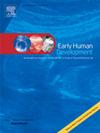多感觉刺激和启动(MuSSAP)上肢训练对3-8月龄单侧脑损伤婴儿的有效性——一项回顾性临床队列研究
IF 2
3区 医学
Q2 OBSTETRICS & GYNECOLOGY
引用次数: 0
摘要
多感觉刺激和启动(MuSSAP)是针对单侧脑瘫(CP)高危婴儿的早期上肢训练。MuSSAP旨在增强受影响上肢的意识,促进目标导向运动的启动。本研究在临床环境中评估为期8周的MuSSAP训练对手工能力的有效性。参与者和方法回顾性临床队列研究纳入了28名婴儿(平均校正年龄为0:5.0个月),使用婴儿手部评估(HAI)进行了前(T0),后(T1)和8周随访(T2)的评估。主要结果是HAI“患手得分”,次要结果包括“单位得分”和项目1(“起始侧”)。数据采用线性混合模型进行分析。结果在T0-T1期间(n = 25),患手评分(估计为3.2,p < 0.001)和单位评分(估计为9.7,p < 0.001)的shai得分均有所提高。T1-T2评分保持稳定。从未启动或仅在受限时启动/有时启动或仅在提示时启动/几乎总是自发启动目标导向运动的婴儿数量从T0的8/13/7变化为T1的5/5/15(缺少3例)。在训练后没有开始目标导向运动的5名婴儿中,有3名患有耐药性癫痫。结论mussap可提高单侧脑瘫高危患儿的手操作能力。需要一个更大的随机对照试验,结合基于大脑的措施来进一步研究其有效性和工作机制,特别是对于那些不能用受影响的上肢发起目标导向运动的婴儿。本文章由计算机程序翻译,如有差异,请以英文原文为准。
Effectiveness of multisensory stimulation and priming (MuSSAP) upper limb training in 3–8 months old infants with unilateral brain lesion – a retrospective clinical cohort study
Introduction
Multi Sensory Stimulation And Priming (MuSSAP) is an early upper limb training for infants at high risk of unilateral cerebral palsy (CP). MuSSAP is designed to enhance awareness of the affected upper limb facilitating initiation of goal-directed movements. This study assesses the effectiveness of an 8-week MuSSAP training on manual ability in a clinical setting.
Participants and methods
Twenty-eight infants (mean corrected age at T0: 5.0 months) were included in a retrospective clinical cohort study with assessments pre- (T0), post- (T1) and at 8-week follow-up (T2) using the Hand Assessment for Infants (HAI). The primary outcome was the HAI ‘affected hand score’, secondary outcomes included the ‘unit score’ and item 1 (‘initiates to side’). Data were analysed using linear mixed models.
Results
HAI scores improved between T0-T1 (n = 25) for both affected hand score (estimate: 3.2, p < 0.001), and unit score (estimate: 9.7, p < 0.001). Scores remained stable between T1-T2. The number of infants who never initiated or only when restrained/sometimes initiated or only when prompted/almost always spontaneously initiated goal-directed movements changed from 8/13/7 at T0 to 5/5/15 at T1 (three missing). Of the five infants who did not initiate goal-directed movements after training, three had drug-resistant epilepsy.
Conclusion
MuSSAP appears to improve manual ability in infants at high risk of unilateral CP in a clinical setting. A larger randomized controlled trial incorporating brain-based measures is needed to further investigate its effectiveness and working mechanism, especially for infants who do not initiate goal-directed movements with the affected upper limb.
求助全文
通过发布文献求助,成功后即可免费获取论文全文。
去求助
来源期刊

Early human development
医学-妇产科学
CiteScore
4.40
自引率
4.00%
发文量
100
审稿时长
46 days
期刊介绍:
Established as an authoritative, highly cited voice on early human development, Early Human Development provides a unique opportunity for researchers and clinicians to bridge the communication gap between disciplines. Creating a forum for the productive exchange of ideas concerning early human growth and development, the journal publishes original research and clinical papers with particular emphasis on the continuum between fetal life and the perinatal period; aspects of postnatal growth influenced by early events; and the safeguarding of the quality of human survival.
The first comprehensive and interdisciplinary journal in this area of growing importance, Early Human Development offers pertinent contributions to the following subject areas:
Fetology; perinatology; pediatrics; growth and development; obstetrics; reproduction and fertility; epidemiology; behavioural sciences; nutrition and metabolism; teratology; neurology; brain biology; developmental psychology and screening.
 求助内容:
求助内容: 应助结果提醒方式:
应助结果提醒方式:


